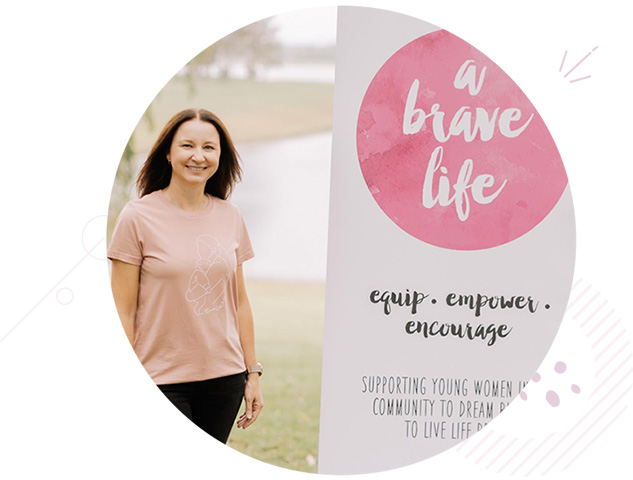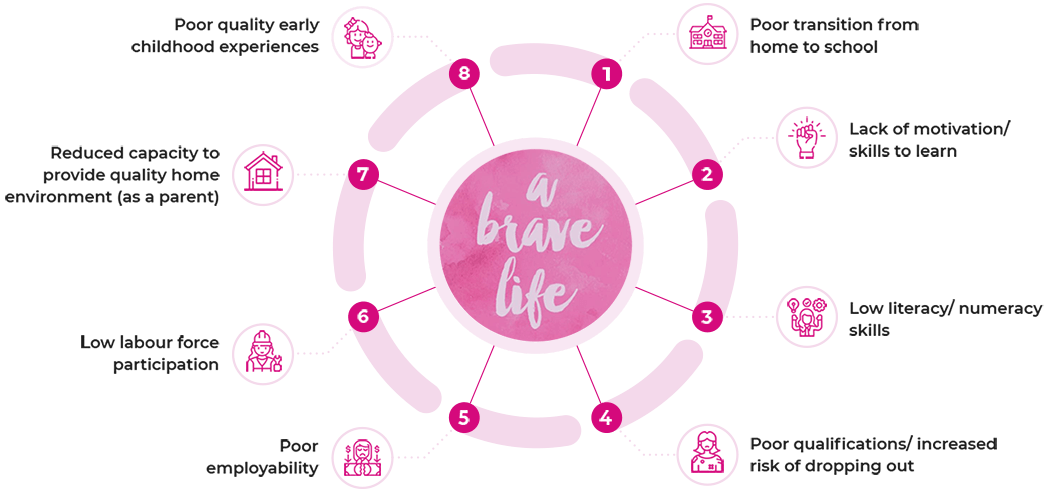
A Brave Life equips and empowers vulnerable mothers facing a
broad range of challenges such as perinatal mental health, domestic violence, poverty, trauma, family and relationship breakdowns, teenage pregnancy and homelessness.
A Brave Life creates pathways for vulnerable women throughout the perinatal period.
Chloe’s early childhood was quite unsettled. Her dad drifted in and out of low-paid jobs. Her mum was a battler but things were always tight. Chloe’s dad could be violent if he was drinking and some of her earliest memories are of hiding from him in fear. When he finally left, she felt relieved, though it made money even tighter.
That backdrop of ongoing poverty, stress, violence and insecurity meant that Chloe struggled to focus at school. She began
truanting in her teens – most of the adults in her life had never finished school and it didn’t seem very important to her.
Chloe got a boyfriend and, for the first time in her life, felt special & wanted. It didn’t last though – he bailed when she got pregnant.
Chloe stopped going to school completely when her beautiful baby boy was born. It’s hard looking after him alone and she worries that she’s not a good enough mum. She doesn’t know how she’ll afford the basics a child needs let alone any of the good stuff. Sometimes it feels like she’s helpless to change a hopeless future.
Chloe’s story is not uncommon. It’s the hidden human pain behind a thousand depressing statistics on early childhood trauma and generational poverty.

Researchers talk about a ‘cycle of disadvantage’ that affects one generation after another. Adverse early life experiences limit school achievement and increase the likelihood of dropping out before gaining qualifications. That makes it harder to find employment, often leading to low income, welfare dependency and difficulty maintaining a stable home or relationship. It’s hard to be a good parent in those circumstances and so the cycle repeats itself.
The early years of a child’s life shape the adult they will become. From conception to age 5, a child’s brain is shaped by the world they experience.

Respond to things that stimulate their brain – but what if no-one plays with them?

Form emotional connections – but lack of a strong bond can cause severe stress that weakens the brain and immune system


Gain physical skills – facing additional challenges if their diet is poor
We should invest in supporting vulnerable parents to provide their children with a strong early childhood that lays the foundations for a positive future.
When we fail to do that, we don’t save any money. We just pay in other ways. We pay for foster care, mental health care, juvenile detention or welfare. Often that costs far more than preventive, early intervention programs like A Brave Life. The London School of Economics estimates the cost of this lost opportunity in England is at least £16.13 billion per year. Let that sink in.
We cannot change a vulnerable woman’s past. But our programs help to change her future and the future of her children and so create a stronger, healthier society.
© Copy Right 2025 All Rights Reserved | Terms and Conditions | Created by Splice Marketing